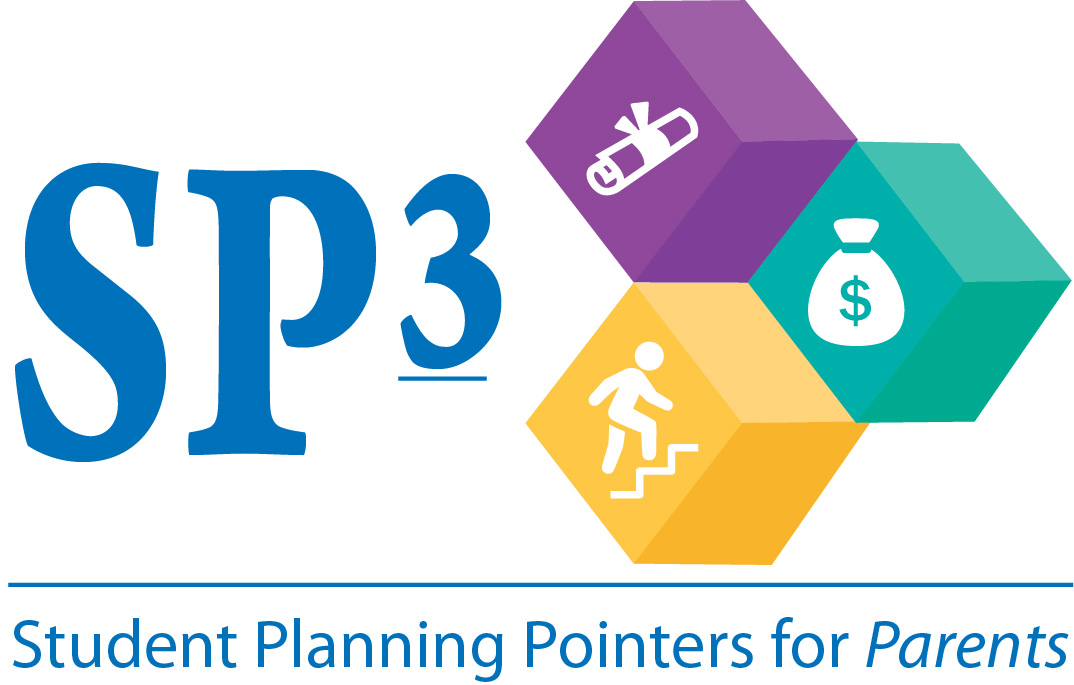Prepare your student for success in college or other postsecondary options, and beyond, by encouraging a balance between academics and extracurricular activities.
Featured Topics

Time Management
Good time management skills help students balance school, homework, activities, family responsibilities and just having fun. Use these tips to help your student learn to prioritize and manage tasks.
- Make a list of all assignments and tests, including estimated completion time.
- Create a schedule and to-do lists.
- Set priorities for the most important tasks.
- Discover issues that cause procrastination or avoidance and solve those.
- Dedicate time to get things done well in advance of deadlines.
Read more about how to build time management skills.

Involvement
Being involved in extracurricular, athletic, academic and work activities can help your student:
- Learn goal-setting, work ethic and self-discipline.
- Increase academic performance.
- Build skills and connections.
- Improve college admission chances.
Be mindful of the number of your student's activities so they don't interfere with academic success.
See more reasons for your student to get involved.

Academic Success
Encourage good study and classroom habits now to help ensure your student will be able to manage more advanced coursework later. Your student should:
- Use a planner to record assignments and set aside time to complete work.
- Review notes daily.
- Set goals for completing homework and increasing scores.
- Attend review sessions before tests and study the topics that are highlighted.
- Understand what went wrong on tests.
- Try out different study locations and methods. Study in short, frequent bursts.
- Discuss the GPA, standardized test score and class requirements for colleges or programs your student is interested in.
- Help your student plan for high school classes that provide college credit, like dual enrollment or Advanced Placement.
- Help your student understand that taking challenging classes and getting good grades may lead to more future options for colleges and careers.

Reading
Reading and comprehension play an important role in academics and career. Help your student learn to read for success.
- Suggest books or other materials your student might be interested in reading.
- Allow your student to see you reading, and discuss books and other media with them.
- Listen to audiobooks with your student as you are driving in the car.
- Ask your student to tell you about the book they are reading.
- Read the same book as your student and discuss it with them.
See more tips on how to encourage reading.
Help your students determine their desired career field by exploring the various types of careers, and the related education requirements, with them.
Featured Topics

Types of Careers
While many jobs require some education or training after high school, the type of education may vary depending on career goals. Help your student explore career types to narrow down the postsecondary options to pursue.
- Talk about the different careers you know of or encounter in daily life.
- Help your student connect current interests with potential jobs.
- Discuss specific skills and how they are used in the jobs your student is interested in, as well as related careers.
- Use surveys or career-matching programs, such as those provided by ACT, to help your student identify potential careers based on interests and abilities.
- Set up opportunities for your student to job shadow, volunteer and talk to people working in their targeted careers.

Postsecondary Options
Depending on the type of career you student wants to pursue, he or she may have several options for education or training after high school. Identify the certificate or degree required for your student's career interest using tools like the ACT Profile or the Return on College Investment Tool from ISL Education Lending.
- On-the-job training. If your student enters the workforce without additional education, he or she may need to rely on learning new skills or taking training to advance.
- Military. Service members may acquire career training and education while they serve their country, and they may receive additional benefits to pursue education after leaving the military.
- Short-term education. Many students complete short professional programs, certificate programs or associate degrees in nine months to two years.
- Apprenticeship. Usually a combination of on-the-job training and classroom education, apprenticeships may pay a living wage while your child learns a trade or skill over several years.
- College. Your student may wish to pursue a bachelor's, or even a more advanced degree, from a public or private college or university.

Expected Starting Salaries
Understanding realistic starting salaries for different careers is an important component in considering career choices. You and your student should consider:
- How starting salaries differ from average or mid-career salaries for any given career.
- The way actual starting salaries affect the lifestyle your student hopes to achieve. Resources like the Return on College Investment tool from ISL Education Lending can help.
- How a person's level and type of education affect his or her starting salary.
- The connection between expected starting salaries and the recommended maximum amount of borrowing for obtaining the required training.
- The effect of geography, economy, technology, demand and other factors on job availability and starting salaries.
Use these steps and important actions to help your student choose and enter their choice for education or training after high school.
Featured Videos
Full video transcript
Understanding College Costs
There's more to the cost of college than just tuition or room and board. Understanding all the costs associated with college is important for properly planning and paying for college.
Full video transcript
College Visits 101
College visits are a great way to learn more about a specific college, its programs, and college life, as well as determine if it is the right fit for your student.
Featured Topics

Explore Options
The following steps can help you and your student discover college programs.
- Early in the college selection process, investigate a variety of campuses that offer appropriate programs for your student's desired career. They may vary in size, distance from home, undergraduate vs. graduate research focus, and a variety of other factors. Use these factors to help narrow choices.
- Consider finances and cost of attendance for schools. A net cost calculator can help; just search online for the college name and "net cost calculator."
- Online tours and websites, including social media sites like Reddit, Rate My Professor, Facebook and Twitter, can provide a wealth of information.
- Make a list of campuses for formal visits. Use these opportunities to meet with faculty and admissions and financial aid staff. If it's an available option, your student may want to sit in on a class.
Here are some additional steps to take if your student is considering education or training other than college.
- Talk to those who currently work or serve in the field about their training and careers.
- Review information available online about the programs; regional, national and international organizations; and available jobs now and in the future for the options under consideration.
- Visit with a recruiter or representative who is knowledgeable about the choices within the field. For example, a student interested in joining the U.S. Navy may also want to learn about the opportunities available through the Marine Corps or the Coast Guard.

Finding the Right Fit
The ideal choice for your student to pursue after high school may depend on several factors. The importance of each varies by student and his or her future goals. These aspects may play a role for your family:
- Does the college have a highly rated program in your student's field of study?
- Does the college or program have high placement rates for jobs in your student's field of study?
- Can you afford the college or program?
- Can your student succeed academically?
- Can your student meet the admission requirements?
- Will your student be comfortable attending?
See more about helping your student choose a college.

Financial Considerations
The cost of education in the United States continues to rise every year, making money one of the main considerations in choosing a program or pursuing a career. Set expectations early with your student to ensure your family can afford your student's final choice.
- Know what the cost of attendance is. For college and many training programs, this amount includes tuition and required fees, housing and meals, and estimated costs for transportation, books, materials and personal expenses. Apprenticeships may actually pay apprentices to work while they learn a new trade. Costs for joining the military may be little or none.
- Understand your student's cost. Scholarships, grants and work-study can offset some costs. In addition, your student may not spend as much (or may spend more than) estimated costs for transportation, books, materials and personal items. The choices your student makes can also reduce estimated costs for housing and meals. College-bound students can use the college's net cost calculator to estimate actual cost.
- Compare like to like. Program materials may show different expenses or group them differently. Compare carefully to be sure you understand any savings from one institution to another.
- Make a plan. Think about your family's savings and earnings, as well as your student's. How much are you able or willing to pay toward your student's costs, considering additional children and your own retirement plans? Will your student work during college? Are loans available for the program? Will available federal student loans, which are limited to a specific amount each year, cover the difference? Will you cosign or take out additional loans for your student? Is the total estimated debt a reasonable amount based on your student's future ability to pay? In addition, remember that many costs increase every year.
- Set expectations. Have a real conversation with your student about how much you plan to contribute and what will be expected of him or her. Discuss how budget may affect the college or educational option your student will pursue.

College Application Process
The application process can be overwhelming for families. Below are some main considerations. A separate process may apply to specific majors or programs within a college or university, and students should watch for email or online notifications of missing or added requirements.
- Admission basis. Some colleges offer rolling admission, accepting any student who meets admission requirements before a certain date. Others are more selective and compare students against the rest of the applicant pool before deciding whom to admit.
- Deadlines. Early deadlines may be binding or non-binding or may increase a student's chance of admission. Students should plan ahead to meet the deadlines for every institution to which they plan to apply.
- Application type. Many colleges use the Common App or another shared application process, making it easier to apply to multiple colleges.
- Application requirements. Students may be required to submit one or more personal statements, essays, letters of recommendation, academic records and standardized test scores and list high school activities and honors. You can help by proofreading these before they are submitted.
- Application boosters. Some colleges consider the level of student interest during the admission process. Your student might indicate interest by campus visits, subscribing to email lists or following the college's admissions office on social media, communicating with staff, participating in alumni or faculty interviews, or other methods.
- Financial aid application. Most institutions recommend, and some require, that students and families complete the Free Application for Federal Student Aid, or FAFSA, whether or not they anticipate needing financial aid. Colleges often use this application as a basis for scholarships and grants. Some colleges and universities also have a separate financial aid form or process that must be completed by a certain date.
- Commitment dates. After your student has been notified of acceptance and any financial aid offers, he or she should pay attention to commitment dates. Nationally, May 1 is considered Decision Day, but accepting admission before that date may provide advantages in registration dates, housing selection or scholarship consideration.
See what you need to know about college applications.

Apply to a Range of Colleges
The admission process can be unpredictable, and every year some students are surprised by either their admission results or their own final selection. Multiple acceptances create a safety net in the following situations.
- Admission at many institutions is based on a holistic approach that considers each student's fit within the student body. Even stellar students are turned away from highly selective colleges.
- A financial aid offer may be lower than expected. Also, the school's financial situation may change, resulting in increased costs or fewer or reduced need- or merit-based awards than anticipated.
- The family's financial situation can change. A job loss or large medical bills can reduce a family's ability to pay for a student's cost of attendance.
- A high school senior may change his or her mind about the type of college to attend, the intended field of study or comfort level in being away from friends and family, among other things.
- An in-person visit to campus or interactions with the college after acceptance may result in a student or family deciding a particular school is not for them.
- Poor academic performance or other situations after acceptance may result in a rescinded admission offer or reduced chances for scholarships, honors programs or other options.

Applying for Other Options
Application requirements for other educational or training programs vary and may overlap with the requirements to apply for a four-year college. Some of the most common options are listed below. For specialized programs, such as those in automotive, health and culinary fields, the required training, certification and application requirements vary.
Military
- Armed Services Vocational Aptitude Battery (ASVAB) test
- Physical exam
- Career field selection
Community College
- Application
- Standardized tests or assessments of academic skills
- Program or course prerequisites
Apprenticeship Requirements
- Possibly minimum age
- May require community college acceptance
- Specific trade requirements
The cost of a college education is one of the most important considerations in planning for life after high school. Use this information to help your family prepare.
Featured Videos
Full video transcript
Determining Loan Need
Before you or your student take out any loans for college, you first need to figure out exactly what amount you might need to borrow.
Full video transcript
Benefits of Saving
Saving for college is one of the best ways to help manage costs. Whether it is you or your child doing the saving, every little bit saved helps reduce the amount you or your child may need to borrow, or savings can help cover small, unexpected costs.
Full video transcript
Filing the FAFSA
Filling out the Free Application for Federal Student Aid, or FAFSA, is an important step in your student’s college career. Find out the basics of what you need to get started.
Full video transcript
How Student Loans Work
If a student in your life is headed to college, they may be relying on financial aid to cover some or all of the cost of attendance, including federal or private loans.
Full video transcript
Types of Student Loans
Before you or your student take out a student loan, you should know the differences between the types of loans available.
Full video transcript
How Interest Works
If you or your student use loans to help pay for college, you will need to pay some form of interest on the loans.
Featured Topics

Saving as a Family
Save early and save often when planning for college. Some important considerations:
- Choose how you will save. Each of these savings options offers different benefits and advantages, so weigh them carefully.
- 529 plans, also called college saving accounts.
- Education Savings Accounts (ESAs), such as Coverdell.
- Saving accounts.
- Savings bonds.
- Certificates of Deposit.
- Stock, mutual fund and other investment accounts.
- Employer-sponsored education plans.
- Trust funds and other inheritance or gift options.
- Save for yourself too. Saving for your child's college education is important, but experts say you shouldn't bankrupt yourself, sacrifice retirement savings or take undue risks like an unaffordable second mortgage or a large Federal Direct PLUS Loan.
- Understand tax consequences. The savings option you choose may carry certain tax benefits, or withdrawals may result in penalties. Be sure to consult with a financial adviser or tax professional if you have tax questions.
- Know the effects of assets on need-based aid. Family-owned businesses, college savings and other assets may reduce the amount of need-based aid available to your student. A financial adviser familiar with college financial aid and family finances may be a good resource, or if your student has interest in specific schools, you may wish to check with the financial aid or admissions staff.
- Saving is better than borrowing. Savings of $20,000 for college results in a $20,000 contribution. The same amount in student loan debt, however, will generate interest that will need to be repaid on top of the original debt.
See how saving compares to borrowing for college costs.

Student Contributions
Your student may be able to contribute a significant amount to his or her own education costs by:
- Earning money before college.
- Earning money during college.
- Reducing everyday expenses to free up available money for college costs.
- Avoiding large purchases and putting that money toward education instead.
- Earning scholarships and grants.
- Using gifts, inheritance and other income.
Work with your student to determine the best ways to accumulate income before and during college to reduce the need to borrow. Use your budget strategy as an example for your student and work with him or her to create a personal budget using savings and earnings, such as an allowance, to see the impacts of their spending.
If your student's school offers a personal finance course, encourage him or her to enroll in it.

Scholarships and Grants
Scholarships and grants, unlike student loans, don't need to be repaid. Grants are often awarded by the government or the college itself, but scholarships may come from a variety of sources. Here's how you can help your student in the scholarship search.
- Compare bottom lines. The largest scholarship awards generally come from colleges themselves. See what is available from the colleges your student is considering and the various requirements to receive guaranteed and competitive awards. Then, show your student how the financial picture changes with and without these awards.
- Search early and frequently. Scholarships are available from employers, local organizations, national companies and individuals, and they all have their own requirements and criteria. Brainstorm and search free online databases early for sources and check them frequently to be sure your student is aware of all available opportunities and application deadlines.
- Be a cheerleader. With college applications, senior year homework and activities, and other commitments, completing many scholarship applications can be overwhelming. Be prepared to encourage your student to keep his or her eyes on the potential reward.
You can help your student plan ahead for scholarships.

Family Contributions
An estimate of your student’s need for financial aid will be included in the financial aid offers your student receives from colleges. Here's what you need to know:
- The Student Aid Index (SAI) is based on the tax and financial information reported in the Free Application for Federal Student Aid (FAFSA).
- The federal SAI is based on a government formula and determines how much financial aid your student will be offered.
- Individual colleges and universities may also use the financial aid information provided to determine how much institutional aid is offered to your student.
- You may feel you have more or less need, depending on your own financial situation and the type of assets included in the calculation.
- If financial changes aren't reflected in the information you submitted, you may be able to work with a college to adjust the available financial aid.
- Your contribution may come from previously built-up savings or current earnings.
- In addition to helping your student with current costs, you can help reduce the amount he or she will need to repay later by helping with payments that at least cover interest on student loans while your student is still in college.
- Work with a financial or tax adviser to understand how your investment and financial decisions impact college financing and financial aid.

Loans
Student loans are different from many other types of consumer credit. Here are some important things to know:
- The total amount to be repaid is usually more than the total amount borrowed, due to the daily accrual of interest and any origination, late or other fees.
- To increase a student's chances of managing repayment successfully, experts recommend total borrowing for a student's education be no more than the expected first-year salary.
- Students are limited to a certain amount in federal student loans each year. Additional loan funds generally need to be taken out by the parent or cosigned by a creditworthy cosigner.
- Student loans, in general, cannot be dismissed in bankruptcy or if the student does not earn a degree or find a desirable job.
- Student loans accrue interest on a daily basis from the date they are first disbursed. The federal government covers interest on subsidized federal loans while the student is in school and at certain other times; all other interest is the responsibility of the borrower.
- Unpaid, accrued interest may capitalize, or be added to the principal balance, at certain times, such as when the student leaves school or an assistance period ends. The entire new balance will then begin to accrue interest daily.
- Borrowers can make interest payments or principal payments at any time without penalty on federal student loans and many private student loans. Making payments that at least cover accruing interest when payments are not required, such as when the student is attending school, can help reduce the total amount paid over the life of the loan.
- Extra payments may not pay down outstanding principal but may be applied to future payments due. Borrowers should work with their lender or servicer directly to understand how to best handle extra payments.
- Borrowers with federal student loans may be eligible for payment plans based on income.
- Some lenders offer interest rate reductions for on-time or automatic electronic payments or offer other benefits.

Reducing Cost
Students' choices can make a large difference in how much they spend on, and need to borrow to pay for, their college educations. Simple savings like these can add up.
- Choosing a less expensive college or educational path.
- Reducing living costs by living at home or further from campus. Roommates can also help by sharing rent and utility costs.
- Taking public transportation when possible and biking or walking shorter distances.
- Renting, sharing or buying used textbooks.
- Preparing meals and beverages at home and dining in when not on a required or purchased meal plan.
- Using discounts like coupons and daily deals for groceries, supplies and entertainment.
- Asking for student rates.
- Giving up expensive habits.
- Maintaining health.
- Staying on track to graduate on time by deciding early on a major, working with an adviser to take the appropriate classes on time and maintaining good grades.

Salary vs. Debt
Experts recommend monthly student loan payments be no more than 8%–12% of a person's future monthly pay, a ratio called the "student loan debt-to-income ratio." An easier way to think of this is to borrow no more than a realistic one-year starting salary for the future career. Here is one way to determine a maximum annual student loan amount:
- Determine a realistic starting annual salary. Keep in mind that average or mid-career salaries for any given profession are likely higher than first-year salaries.
- Divide the starting salary by the number of years expected to earn the degree. Many students take five or six years to earn a bachelor's degree for a variety of reasons.
- The result is the maximum recommended borrowing level for a single year.
Ready for more information on how to help your student? You've come to the right place.

Twice-Monthly Information by Email
Sign up for SP3 — Student Planning Pointers for Parents. You'll receive two emails a month with links to articles specifically for parents of eighth- through 12th-grade students. Each article is timely and targeted to your student's grade level.
You also have a chance to enter a random drawing for a quarterly $250 college saving plan deposit with each email you receive.

Printable Tips for Parents
Print or save these tips (PDF) to help your student prepare for success.